![]()
![]()
![]()
Use LEFT and RIGHT arrow keys to navigate between flashcards;
Use UP and DOWN arrow keys to flip the card;
H to show hint;
A reads text to speech;
31 Cards in this Set
- Front
- Back
- 3rd side (hint)
|
Paper logbook |
1: deferred maintenance 2: mission schedule 3: fueling/defueling, fuel samples 4: maintenance discrep report
|
|
|
|
Paper forms |
Preflight and servicing: yellow Mission record: blue Mission generated: pink Flight safety maintenance: pink |
Colours |
|
|
Type 1 material |
Aircraft engines High value component Requiring special config Critical supply and of sufficiently high cost, low volume |
Vroom vrooooom.. Serial number |
|
|
Type 2 material |
Service Wide support responsibility $250 or more Procured from commercial supply Flight critical Repairable |
|
|
|
Type 3 material |
Consumable material Less avionics Less than 250 and procurable from OGA source Units set their own AFC 30 funds |
|
|
|
Type 4 |
Unit price of $800+ Procured from commercial source Flight critical Repairable |
|
|
|
Type 5 material |
Consumable avionics material |
|
|
|
Vented NiCad |
Uses strong solution of potassium hydroxide that is alkaline and corrosive. Use rubber gloves, apron, face shield If batt temp heats excessively to 115F may require water to affected cell |
|
|
|
Ventilated Lead Acid |
Ventilated fire proof rooms. Rubber gloves, eye protection, clothing Pour electrolyte into water Never apply heart to lead acid battery which has been removed from charging line or has rapidly discharged under heavy load. |
|
|
|
Non dedicated battery servicing facility |
Air temp maintained 77.5F +- 7.5F Serviced on automatic type battery chargers Fire extinguishers really available Eye wash equipment, portable is acceptable Splash proof chem goggles within arms length Sign saying SEALED BATTERY SERVICING AREA No color code required Neutralizing agent kept nearby |
|
|
|
Fire extinguishers 110 |
No extinguisher shall be blocked off by obstructions Must be inspected, serviced, maintained IAW manufacturer instructions. Shall never be inop Flight line extinguishers shall be IAW ground servicing of aircraft and static grounding bonding AFTO 0025172 |
|
|
|
DD Form 1574 orange serviceable tag |
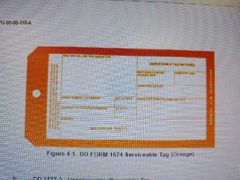
|
|
|
|
DD Form 1577-2 unserviceable reparable tag |
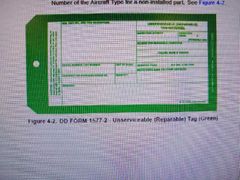
|
|
|
|
DD Form 1577-2 unserviceable reparsble tag blue |
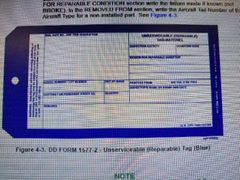
Outside of ALC |
|
|
|
DD Form 1577 unserviceable red |
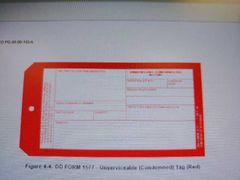
Condemned |
|
|
|
CG 1577 B PQDR |
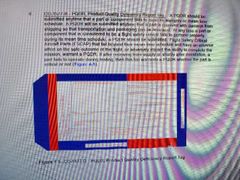
U/R |
|
|
|
TACON Tactical Control |
command authority for aviation forces made available for tasking. TACON is limited to the detailed direction and control of aviation resources in the operational area necessary to accomplish assigned missions. TACON is inherent in OPCON, however the OPCON authority may delegate TACON of a certain number of its assets to another operational element without releasing OPCON. TACON of aviation assets typically rests with the Commanding Officer of the air station for which those assets are assigned. On all flights involving a TACON change, the time and place of TACON shift shall be clearly defined. Normally, TACON of aircraft and crews will shift to gaining unit upon first landing at the new operating location. If this is impractical, or if improved oversight can be attained in another manner, Commanding Officers of the units involved in the TACON change shall agree to a clearly defined time or place of TACON shift. |
|
|
|
PEACE model |
Planning Event complexity Asset Communication and Supervision Environment Memory aid for elements considered essential in safe and effective execution of any mission. To identify, assess, mitigate deficits |
|
|
|
STAAR model |
Spread out Transfer Avoid Accept Reduce Memory aids for potential strategies used to control/ mitigate risk. |
|
|
|
Air Data |
Pitot/ static Speed indicating Altitude indicating Overspeed warning (audible) Air Data computer Uses pitot static system to supply output to associated systems Supplies RAM air to air data system Provides digital outputs pressure, airspeed, total air temp, static air temp, preselected atitude |
|
|
|
Attitude & direction |
Uses magnetic gyroscopic inertial forces and indication Primary function provide measurement of aircraft pitch, roll, heading Euler angles. Magnetic compass, Attitude indicator Flux valve- detects horizontal component of earth's magnetic field, external compensation, unit provides processor necessary |
|
|
|
IFF |
APX 119 receive and identify IFF interrogations from other aircraft or ground stations and to provide valid interrogation reply Receives interrogation from ground radar station, other IFF interrogators, TCAS interrogators. Modes 1, 2, 3A, C or S. Transceiver receive all data input to system and uses this to generate necessary reply from 2 antenna, ensures valid interrogation |
|
|
|
Radalt System |
Provide all data from 2500 above terrain to 0 during the approach phase of flight. 2 processors 4 antenna Generates an RF signal, passes to antenna, measures difference between transmitted and received, calculates height of aircraft Uses: Flight data recorder Data processing Electronic flight instruments GPWS TCAS |
|
|
|
TACAN |
Tactical Air Navigation System Compute from airborne or ground surface beacon -slant range -relative bearing -aircraft velocity -time to go to beacon
Interrogators, set ground or airborne beacon receives replies from beacon, colours necessary data to be displayed to the operator -TACAN transceiver -2 antenna
TR transmit receive sends interrogation signals to set ground station through applicable antenna - relative bear bearing
Air to air
Air to air transmit receive Identical to TR except data comes from airborne beacon
108- 135.95 MHz in 50kHz steps 252 possibilities 001X- 126X & 001Y-126Y
|
|
|
|
TCAS |
Traffic Alert and Collision Avoidance System Continuously monitor airspace around aircraft movement. Calculate safety threat to aircraft from other aircraft movement to advise crew of position of intruder aircraft and level of safety threat. ATC + IFF system transponders have mode C and S- necessary for TCAS. S - unique aircraft identity code to enable identification Mode S - unique aircraft identity code to enable identificationMode C- altitude Mode C- altitude Other Traffic Cyan open diamond non threat Proximate Traffic Cyan filled diamond Monterey but closer Traffic Alert Yellow circle Resolution Advisory Considered imminent threat |
|
|
|
Fuel contaminants |
There are four major classifications of contaminants commonly encountered in aviation fuels: particulates, water, microbes, and surfactants |
|
|
|
Particulates |
Particulates are solid contaminants that will not dissolve in fuel. Most common are iron, rust, scale, sand, and dirt. Other examples are metal particles, lint, particles of filter media, gums, resins, and rubber. The consequences of particulate contamination in aviation fuels may be severe if the material is allowed to reach the aircraft. For example, if fuel filters become plugged, the flow of fuel to the engine is interrupted, resulting in engine failure. b. One method of removing particulates is to provide a minimum of 2 hours for solids to settle before the fuel is withdrawn from the storage tanks. A better method is to recirculate the fuel through filters/separators. The maximum acceptable level of particulate contamination is 2 mg/l. Particulate contamination can be held well below a level of 1 milligram per liter (mg/l) in a properly functioning fuel distribution system. If contamination exceeds 1 mg/l, corrective action should be taken to improve fuel quality. |
|
|
|
Water (contaminant) |
Water is a common contaminant of aviation fuel and exists in three forms: dissolved, entrained, and free water (either liquid or frozen). Of these three, free water is the only form that can be drawn off or separated from the fuel. Dissolved or entrained water can, however, be reduced to free water and then drawn off or separated. The limit for water in aircraft turbine fuel is 10 ppm. |
|
|
|
Microbes |
a. Microbes are microscopic growths found in soil, air, water, and fuel oil. They derive their nutrients from hydrocarbons in the fuel and add their metabolic waste products to the aqueous layer. There is considerable evidence that microbes can survive even in the absence of water. In a fuel storage tank, microbes may propagate at a very high rate. b. Microbes usually appear as a brown slime that adheres to the inner surface of a fuel tank. Both the organisms and their products tend to collect at fuel/water interfaces resulting in mats, slimes, and sludge. If the interface happens to be maintained on or within a filter element, rapid plugging may occur. In addition, this may result in microbes getting through the filter and contaminating fuel downstream of the filter. Filter plugging may also result from the breakup of upstream fungal mats. In some cases, the organisms and their byproducts have softened or destroyed the top coatings of integral fuel tanks and subsequently caused severe corrosion. c. Because microbes thrive in water, a simple and effective method to prevent or retard their growth is to eliminate the water. The presence of slime, sludge, or fungus in fuel being delivered to an aircraft is a reliable indication of the presence of free water and the failure of fuel cleanup equipment. NOTE FSII contains microbial growth inhibitors which are closely moni- tored. |
|
|
|
Surfacants |
a. The term "surfactants" is a contraction of "surface active agents." These soap or detergent-like materials occur naturally in fuel. They may also be introduced in the refining processes by the inclusion of additives into the fuel, or they may be washed off the internal surfaces of containers previously holding other products. Surfactants are usually more soluble in water than in fuel and reduce the interfacial tension between water and fuel; this stabilizes suspended water droplets and contaminants in the fuel. Surfactants adhere to filters/separators and reduce their effectiveness. They also adhere to metal surfaces until surfactant-rich water droplets are formed. The droplets run down the sides of fuel tanks and form puddles in the bottom or in the sumps. Surfactants in large concentrations usually appear as a tan to dark brown liquid with a sudsy-like water/fuel interface. b. Surfactants alone are not a great threat to aircraft. However, because of their ability to suspend water and dirt in fuel and damage filter/separators, they are one of the major contaminants in aviation fuels. |
|
|
|
Miscellaneous contaminants |
a. Miscellaneous contaminants include both soluble and insoluble materials. Fuel can be contaminated by mixing different MIL-SPEC grades of fuel, improper mixing of additives, or by the introduction of foreign materials. When contamination occurs, engine performance can be affected. For example, there can be a reduction in flashpoint due to contamination with other fuels that have a lower flashpoint. There can also be a reduction of FSII effectiveness due to contamination with water. These contaminants are not naturally found in fuel and are usually introduced as a result of human error |
|

